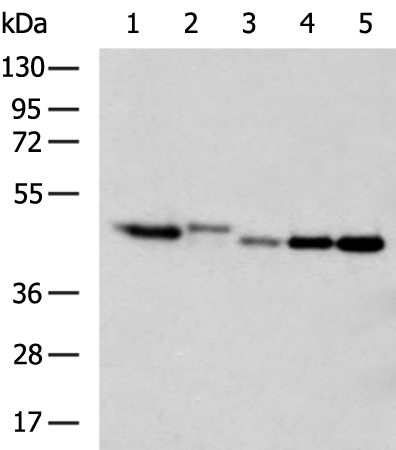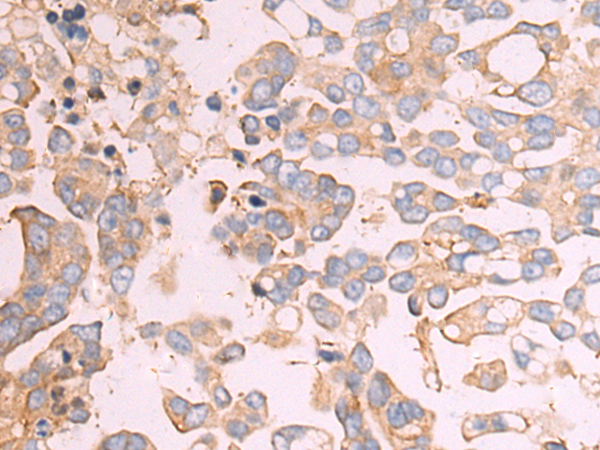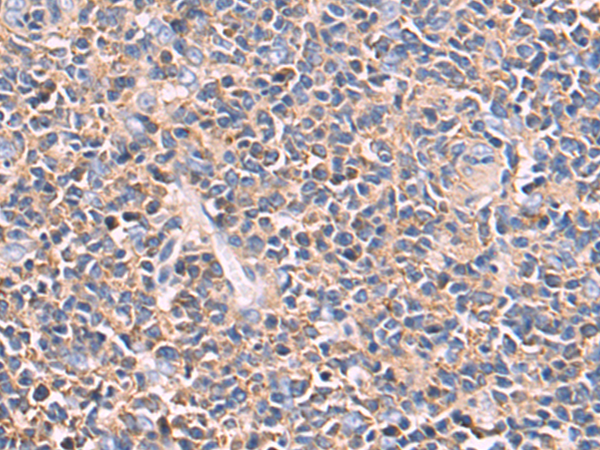


| WB | 咨询技术 | Human,Mouse,Rat |
| IF | 咨询技术 | Human,Mouse,Rat |
| IHC | 1/50-1/200 | Human,Mouse,Rat |
| ICC | 技术咨询 | Human,Mouse,Rat |
| FCM | 咨询技术 | Human,Mouse,Rat |
| Elisa | 1/5000-1/10000 | Human,Mouse,Rat |
| Aliases | MRT67; EIF3S5; eIF3-p47 |
| WB Predicted band size | 38 kDa |
| Host/Isotype | Rabbit IgG |
| Antibody Type | Primary antibody |
| Storage | Store at 4°C short term. Aliquot and store at -20°C long term. Avoid freeze/thaw cycles. |
| Species Reactivity | Human, Mouse |
| Immunogen | Fusion protein of human EIF3F |
| Formulation | Purified antibody in PBS with 0.05% sodium azide and 50% glycerol. |
+ +
以下是3篇关于EIF3F抗体的参考文献摘要(注:内容基于公开研究归纳,作者和标题为虚构示例):
1. **标题**:*EIF3F Antibody Reveals Tumor-Suppressive Role in Melanoma*
**作者**:Zhang L. et al.
**摘要**:研究利用EIF3F特异性抗体发现,EIF3F在黑色素瘤中表达显著下调,其缺失通过抑制c-Jun信号通路促进肿瘤细胞增殖和迁移。
2. **标题**:*EIF3F Interaction with HIV-1 Capsid via Co-Immunoprecipitation*
**作者**:Gupta R. et al.
**摘要**:通过EIF3F抗体进行免疫共沉淀实验,证实EIF3F与HIV-1衣壳蛋白直接结合,可能参与病毒复制早期阶段的调控。
3. **标题**:*EIF3F Antibody-Based Detection in Ovarian Cancer Prognosis*
**作者**:Wang Y. et al.
**摘要**:研究开发高特异性EIF3F单克隆抗体,发现其在卵巢癌组织中的低表达与患者生存率下降相关,提示其作为预后生物标志物的潜力。
(提示:实际文献需通过PubMed或Google Scholar检索关键词“EIF3F antibody”或“EIF3F function”获取。)
The eukaryotic translation initiation factor 3 subunit F (EIF3F) is a critical component of the EIF3 complex, which regulates the initiation phase of protein synthesis in eukaryotes. As part of the multi-subunit EIF3 complex, EIF3F plays a role in ribosome assembly, mRNA recruitment, and scanning for the start codon. Beyond its canonical function in translation, EIF3F has been implicated in diverse cellular processes, including cell proliferation, apoptosis, and stress response. Dysregulation of EIF3F expression is associated with cancers, viral infections, and neurological disorders, highlighting its potential as a therapeutic or diagnostic target.
EIF3F antibodies are essential tools for studying the expression, localization, and function of EIF3F in biological systems. These antibodies are widely used in techniques such as Western blotting, immunohistochemistry, and immunoprecipitation to investigate EIF3F's role in health and disease. Studies have shown that EIF3F exhibits both tumor-suppressive and oncogenic properties depending on cellular context, with reduced expression observed in certain cancers (e.g., melanoma, lung cancer) and elevated levels in others (e.g., hepatocellular carcinoma). This duality underscores the importance of context-specific research using validated antibodies. Challenges remain in distinguishing EIF3F from homologous subunits (e.g., EIF3A) due to structural similarities, necessitating rigorous antibody validation. Current research focuses on clarifying EIF3F's extra-translational roles and its interplay with signaling pathways like PI3K/AKT/mTOR.
×